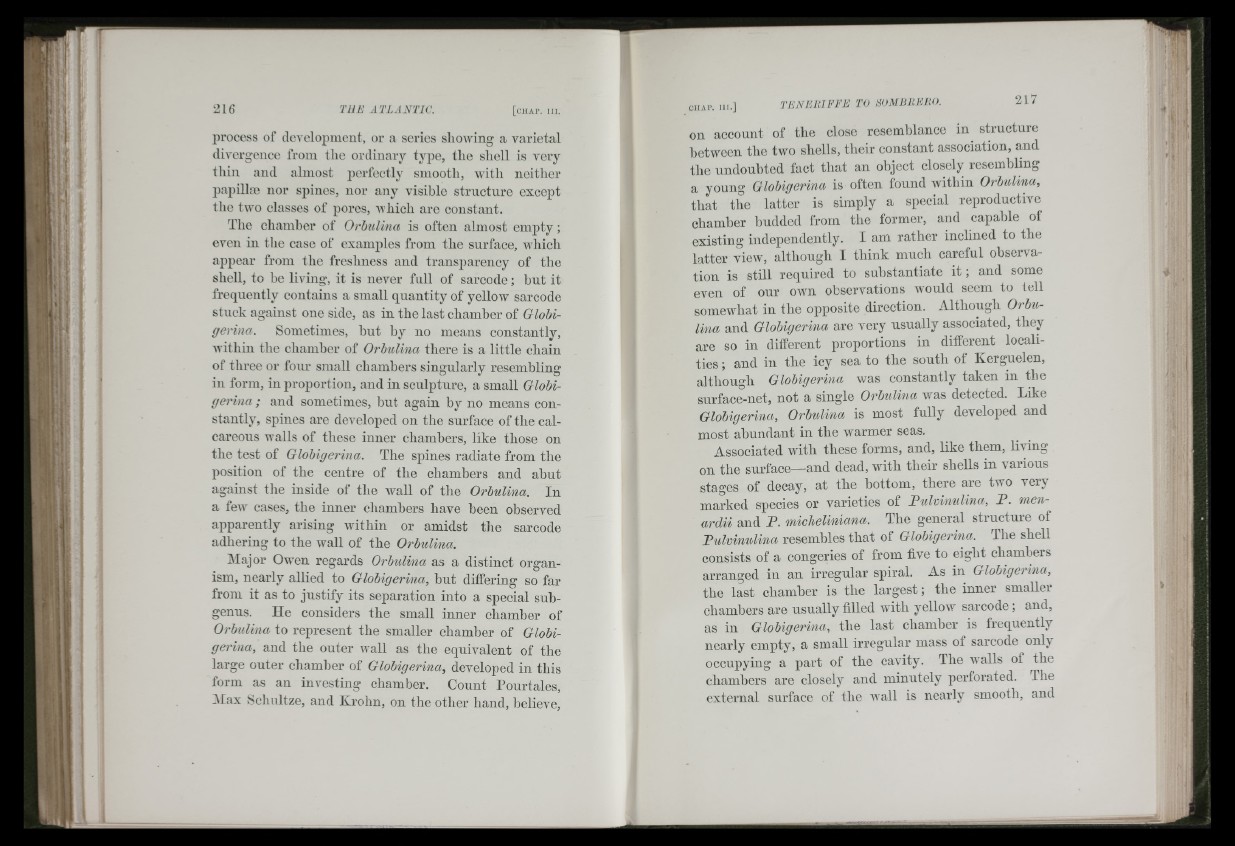
m
M
rIfi [
‘«L A1i. A, i't'l ♦Iii
Iff
-U
I L ..
iF
IIi I> *
II
t/li: ';' « •
àil L ■
ill’
process of development, or a series showing a varietal
divergence from the ordinary typo, the sliell is very
thin and almost perfectly smootli, with neither
papilla) nor spines, nor any visible structure except
the two classes of pores, Avhich arc constant.
The chaiuhcr of Orhulina is often almost empty;
even iu tlie case of examples from the surface, Avhich
appear from the freshness aud transparency of the
shell, to be living, it is never full of sarcode; but it
frequently contains a small quantity of yellow sarcode
stuck against one side, as iu the last chamber of Glohigerina.
Sometimes, but by no means constantly,
Avitliiu the chamber of Orhulina there is a little chaiu
of three or four small chambers singularly resembling
ill form, iu proportion, and iu sculpture, a small Glohigerina
; aud sometimes, hut again by no means constantly,
spines are developed on the surface of the calcareous
walls of these inner chamhers, like those on
the test of Glohigerina. The spines radiate from the
position of the centre of the chambers and abut
against the inside of the wall of the Orhulina. In
a few cases, the inner chamhers have been observed
apparently arising within or amidst tlie sarcode
adhering to the Avail of the Orhulina.
Major Owen regards Orhulina as a distinct organism,
nearly allied to Glohigerina, but differing so far
from it as to justify its separation into a special sub-
genus. He considers the small inner chamber of
Orhulina to represent the smaller chamber of Glohigerina,
and the outer Avail as the equivalent of the
large outer chamber of Glohigerina, developed in this
form as an investing chamber. Count Pourtales,
(Max Schiiltze, and Krolm, on the other hand, helicA'e,
on account of the close resemblance in structure
hetween the two shells, their constant association, and
the undouhtcd fact that an object closely rcsemhliug
a young Glohigerina is often found within Orhulina,
that the latter is simply a special reproductive
chamber budded from the former, and capable of
existing independently. I am rather inclined to the
latter view, although I think much careful observation
is still required to substantiate it ; aud some
even of our own observations would seem to tell
somewhat in the opposite direction. Although Orhulina
and Glohigerina are very usually associated, they
are so in different proportions iu different localities
; and iu the icy sea to the south of Kerguelen,
although Glohigerina was constantly taken in the
surface-net, not a single Orhulina was detected. Like
Glohigerina, Orhulina is most fully developed and
most abundant in the Avarmer seas.
Associated with these forms, aud, like them, living
on the surface—and dead, with their shells iu A'arious
stages of decay, at the hottom, there are tAAO A'ery
marked species or varieties of Pulvinulina, P . menardii
and P . micheliniana. The general structure of
Pulvinulina resembles that of Glohigerina. The shell
consists of a congeries of from five to eight chamhers
arranged in an irregular spiral. As in Glohigerina,
the last chamber is the la rg est; the inner smaller
chamhers are usually filled with yelloAV sarcode; and,
as in Glohigerina, the last chamber is frequently
nearly empty, a small irregular mass of sarcode only
occupying a part of the cavity. The Avails of the
chamhers are closely and minutely periorated. The
external surface of the Avall is nearly smooth, aud
.4; ,